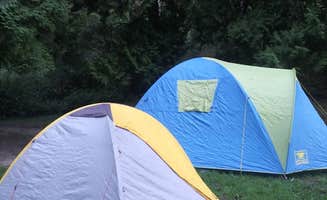Dispersed camping near St. Albans, West Virginia requires travelers to venture across state lines since West Virginia offers limited free camping options. The Ohio border provides the closest opportunities at approximately 90 miles west in Wayne National Forest. This forested region spans over 250,000 acres across southeastern Ohio with elevations ranging from 600 to 1,200 feet. Winter conditions often make forest roads impassable from December through March.
What to do
Horseback riding trails: Sand Hill Trailhead offers primitive camping access along horse trails that connect throughout Wayne National Forest. One visitor noted, "We arrived late at night wishing we had better cell reception and a paper map of the National Forest. We were grateful to have the Dyrt's info downloaded on my chromebook."
Lake activities: Timbre Ridge Lake provides drive-in dispersed camping opportunities near fishing areas. The 100-acre lake sits within a heavily wooded section of the Athens Unit of Wayne National Forest. During summer months, temperatures frequently reach 85-90°F with high humidity.
Trail exploration: Camping in Wayne National Forest allows for direct access to multiple trail systems. According to one camper at Sand Hill Trailhead, "It is a very pretty area along Vesuvius Lake with trees and bluffs." Trails range from 0.5 to 15 miles in length with moderate elevation changes.
What campers like
Natural isolation: The dispersed nature of camping sites provides significant privacy compared to developed campgrounds. Campers frequently report seeing minimal other visitors during weekday trips, particularly in spring and fall seasons.
Cost savings: Free camping options throughout Wayne National Forest provide budget-friendly alternatives to commercial campgrounds. The standard stay limit is 14 days within any 30-day period, after which campers must relocate at least 10 miles away.
Wildlife viewing: The forest environment supports numerous wildlife species including white-tailed deer, wild turkey, and various songbirds. Early morning hours offer the best wildlife observation opportunities, typically between 5:30-8:00 AM.
What you should know
Navigation challenges: Forest roads throughout dispersed camping areas near St. Albans are primarily unpaved and unmarked. According to one visitor, "Wayne National Forest is a maze of public and private land. Next time I will purchase a paper map before I go because Wayne National Forest has a lot of private lands interspersed and it is not all that clear without an official map."
Limited facilities: Dispersed camping sites provide no developed amenities. Campers must pack in all necessary supplies including drinking water, food storage containers, and waste disposal bags. The nearest supply points are typically 15-20 miles from camping areas.
Ranger presence: Forest Service personnel patrol dispersed camping areas regularly. One camper shared, "We saw a ranger in the morning and he suggested next time we just camp at the horsecamp." Rangers check for compliance with regulations including proper food storage, campfire safety, and stay limits.
Tips for camping with families
Site selection priorities: When camping with children, choose locations with level ground and natural boundaries. Campsites near but not directly beside water features provide both convenience and safety.
Navigation preparation: Families should bring physical maps and compass or GPS units programmed with waypoints. Cell service remains unreliable throughout most dispersed camping areas near St. Albans, particularly in valley locations.
Safety precautions: Pack comprehensive first aid supplies including wound care materials and medications. The nearest emergency medical facilities are typically 30-45 minutes away from camping locations.
Tips from RVers
Road conditions: Most forest roads in Wayne National Forest have limited clearance and turning radius. Vehicles longer than 25 feet will encounter significant challenges on unmaintained roads leading to dispersed camping areas.
Leveling requirements: Bring substantial leveling blocks as most natural parking areas feature uneven terrain. RVers should anticipate needing 3-4 inches of leveling capacity at minimum.
Seasonal considerations: Spring access often presents mud hazards while summer brings dense vegetation that may scratch vehicle exteriors. Fall offers the most favorable conditions for larger vehicles with cooler temperatures and reduced undergrowth.


